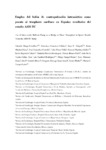Mostrar o rexistro simple do ítem
Empleo del balón de contrapulsación intraaórtico como puente al trasplante cardiaco en España: resultados del estudio ASIS-TC
| dc.contributor.author | Barge-Caballero, Eduardo | |
| dc.contributor.author | González-Vílchez, Francisco | |
| dc.contributor.author | Delgado, Juan F. | |
| dc.contributor.author | Mirabet-Pérez, Sonia | |
| dc.contributor.author | González-Costello, José | |
| dc.contributor.author | Pérez-Villa, Félix | |
| dc.contributor.author | Martínez-Sellés, Manuel | |
| dc.contributor.author | Segovia-Cubero, Javier | |
| dc.contributor.author | Hervás-Sotomayor, Daniela | |
| dc.contributor.author | Blasco-Peiró, Teresa | |
| dc.contributor.author | De la Fuente-Galán, Luis | |
| dc.contributor.author | Garrido-Bravo, Iris P. | |
| dc.contributor.author | Rábago-Juan-Aracil, Gregorio | |
| dc.contributor.author | Muñiz, Javier | |
| dc.contributor.author | Crespo-Leiro, María Generosa | |
| dc.date.accessioned | 2022-03-17T11:26:18Z | |
| dc.date.available | 2022-03-17T11:26:18Z | |
| dc.date.issued | 2018 | |
| dc.identifier.citation | Barge-Caballero E, González-Vílchez F, Delgado JF, Mirabet-Pérez S, González-Costello J, Pérez-Villa F, et al. Empleo del balón de contrapulsación intraaórtico como puente al trasplante cardiaco en España: resultados del estudio ASIS-TC. Rev Esp Cardiol. 2019;72(10):835-843 | es_ES |
| dc.identifier.issn | 0300-8932 | |
| dc.identifier.uri | http://hdl.handle.net/2183/30041 | |
| dc.description.abstract | [Resumen] Introducción y objetivos. En España, el balón de contrapulsación intraaórtico (BCIA) se ha usado frecuentemente como puente al trasplante cardiaco (TxC) urgente. El propósito es analizar los resultados de esta estrategia. Métodos. Se realizó una revisión retrospectiva caso por caso de los registros clínicos de 281 pacientes adultos listados para TxC urgente asistidos con BCIA en 16 hospitales españoles entre 2010 y 2015. Se analizaron la supervivencia antes y después del trasplante y la incidencia de eventos adversos. Resultados. Se trasplantó a 194 pacientes (69%; IC95%, 63,3-74,4) y 20 (7,1%; IC95%, 4,4-10,8) fallecieron durante la asistencia, cuya duración media fue de 10,9 ± 9,7 días. El BCIA se explantó antes de obtener un órgano a 32 pacientes (11,4%). En 35 pacientes (12,5%; IC95%, 8,8-16,9) se implantó un dispositivo de asistencia circulatoria mecánica completa. El tiempo en la lista de espera urgente se incrementó desde 5,9 ± 6,3 días en 2010 hasta 15 ± 11,7 días en 2015 (p = 0,001). La supervivencia a 30 días y a 1 y 5 años tras el TxC fue del 88,1% (IC95%, 85,7-90,5), 76% (IC95%, 72,9-79,1) y 67,8% (IC95%, 63,7-71,9) respectivamente. La tasa de incidencia de eventos adversos mayores —disfunción del BCIA, ictus, hemorragia o infección— durante la asistencia fue de 26 (IC95%, 20,6-32,4) eventos/1.000 pacientes-día. La tasa de incidencia de explante del BCIA por complicaciones fue de 7,2 (IC95%, 4,5-10,8) casos/1.000 pacientes-día. Conclusiones. En el contexto de listas de espera cortas, el BCIA puede utilizarse como puente al TxC urgente con resultados aceptables. Esta estrategia conlleva una incidencia significativa de eventos adversos. | es_ES |
| dc.description.abstract | [Abstract] Introduction and objectives. In Spain, intra-aortic balloon pump (IABP) has been used frequently as a bridge to urgent heart transplant (HT). We sought to analyze the clinical outcomes of this strategy. Methods. We conducted a case-by-case, retrospective review of clinical records of 281 adult patients listed for urgent HT under IABP support in 16 Spanish institutions from 2010 to 2015. Pre- and post-transplant survival and adverse clinical events were analyzed. Results. A total of 194 (69%, 95%CI, 63.3-74.4) patients were transplanted and 20 (7.1%, 95%CI, 4.4-10.8) died during a mean period of IABP support of 10.9 ± 9.7 days. IABP support was withdrawn before an organ became available in 32 (11.4%) patients. Thirty-five (12.5%, 95%CI, 8.8-16.9) patients transitioned from IABP to full-support mechanical devices. Mean urgent waiting list time increased from 5.9 ± 6.3 days in 2010 to 15 ± 11.7 days in 2015 (P = .001). Post-transplant survival rates at 30-days, 1-year, and 5-years were 88.1% (95%CI, 85.7-90.5), 76% (95%CI, 72.9-79.1), and 67.8% (95%CI, 63.7-71.9), respectively. The incidence rate of major adverse clinical outcomes—device dysfunction, stroke, bleeding or infection—during IABP support was 26 (95%CI, 20.6-32.4) episodes per 1000 patient-days. The incidence rate of IABP explantation due to complications was 7.2 (95%CI, 4.5-10.8) cases per 1000 patient-days. Conclusions. In a setting of short waiting list times, IABP can be used to bridge candidates to urgent HT with acceptable postoperative results, but there were significant rates of adverse clinical events during support. | es_ES |
| dc.language.iso | spa | es_ES |
| dc.publisher | Elsevier | es_ES |
| dc.relation.uri | https://doi.org/10.1016/j.recesp.2018.07.006 | es_ES |
| dc.rights | Atribución-NoComercial-SinDerivadas 3.0 España | es_ES |
| dc.rights.uri | http://creativecommons.org/licenses/by-nc-nd/3.0/es/ | * |
| dc.subject | Balón de contrapulsación intraaórtico | es_ES |
| dc.subject | Asistencia circulatoria mecánica | es_ES |
| dc.subject | Trasplante cardiaco | es_ES |
| dc.subject | Intra-aortic balloon pump | es_ES |
| dc.subject | Mechanical circulatory support | es_ES |
| dc.subject | Heart transplant | es_ES |
| dc.title | Empleo del balón de contrapulsación intraaórtico como puente al trasplante cardiaco en España: resultados del estudio ASIS-TC | es_ES |
| dc.title.alternative | Use of Intra-aortic Balloon Pump as a Bridge to Heart Transplant in Spain: Results From the ASIS-TC Study | es_ES |
| dc.type | info:eu-repo/semantics/article | es_ES |
| dc.rights.access | info:eu-repo/semantics/openAccess | es_ES |
| UDC.journalTitle | Revista Española de Cardiología | es_ES |
| UDC.volume | 72 | es_ES |
| UDC.issue | 10 | es_ES |
| UDC.startPage | 835 | es_ES |
| UDC.endPage | 843 | es_ES |
Ficheiros no ítem
Este ítem aparece na(s) seguinte(s) colección(s)
-
INIBIC-ICATC - Artigos [174]






